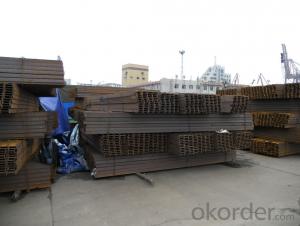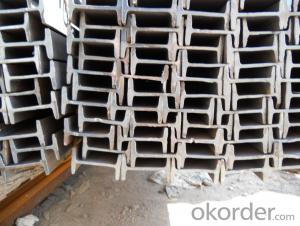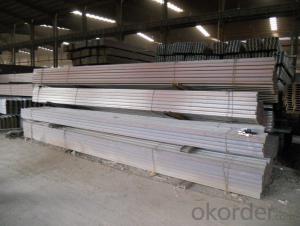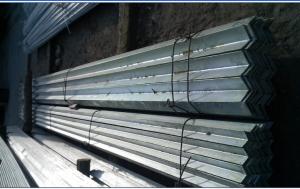IPEAA, IPE Steel Beams
- Loading Port:
- Tianjin
- Payment Terms:
- TT OR LC
- Min Order Qty:
- -
- Supply Capability:
- 100000 m.t./month
OKorder Service Pledge
OKorder Financial Service
You Might Also Like
Specifications of IPE/IPEAA Beam Steel
1. Product name: IPE/IPEAA Beam Steel
2. Standard: EN10025, GB Standard, ASTM, JIS etc.
3. Grade: Q235B, A36, S235JR, Q345, SS400 or other equivalent.
4. Length: 5.8M, 6M, 9M, 10M, 12M or as your requirements

Section | Standard Sectional Dimensions(mm) | ||||
| h | b | s | t | Mass Kg/m |
IPE80 | 80 | 46 | 3.80 | 5.20 | 6.00 |
IPE100 | 100 | 55 | 4.10 | 5.70 | 8.10 |
IPE120 | 120 | 64 | 4.80 | 6.30 | 10.40 |
IPE140 | 140 | 73 | 4.70 | 6.90 | 12.90 |
IPE160 | 160 | 82 | 5.00 | 7.40 | 15.80 |
IPE180 | 180 | 91 | 5.30 | 8.00 | 18.80 |
IPE200 | 200 | 100 | 5.60 | 8.50 | 22.40 |
IPE220 | 220 | 110 | 5.90 | 9.20 | 26.20 |
IPE240 | 240 | 120 | 6.20 | 9.80 | 30.70 |
IPE270 | 270 | 135 | 6.60 | 10.20 | 36.10 |
IPEAA80 | 80 | 46 | 3.20 | 4.20 | 4.95 |
IPEAA100 | 100 | 55 | 3.60 | 4.50 | 6.72 |
IPEAA120 | 120 | 64 | 3.80 | 4.80 | 8.36 |
IPEAA140 | 140 | 73 | 3.80 | 5.20 | 10.05 |
IPEAA160 | 160 | 82 | 4.00 | 5.60 | 12.31 |
IPEAA180 | 180 | 91 | 4.30 | 6.50 | 15.40 |
IPEAA200 | 200 | 100 | 4.50 | 6.70 | 17.95 |
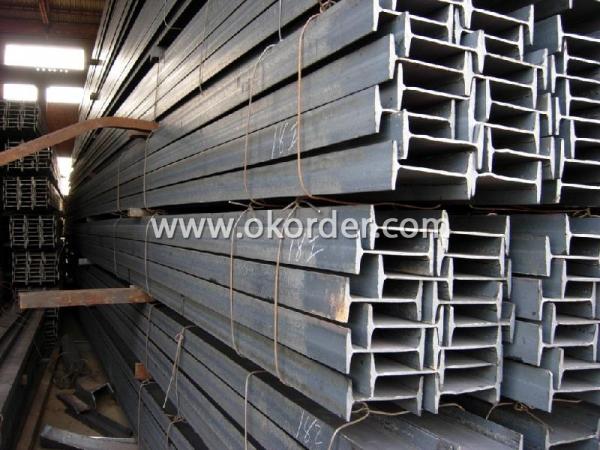
Applications of IPE/IPEAA Beam Steel
IPE/IPEAA Beam Steel are widely used in various construction structures, bridges, autos, brackets, mechanisms and so on.
Packing & Delivery Terms of IPE/IPEAA Beam Steel
1. Package: All the IPE/IPEAA Beam Steel will be tired by wire rod in bundles
2. Bundle weight: not more than 3.5MT for bulk vessel; less than 3 MT for container load
3. Marks:
Color marking: There will be color marking on both end of the bundle for the cargo delivered by bulk vessel. That makes it easily to distinguish at the destination port.
Tag mark: there will be tag mark tied up on the bundles. The information usually including supplier logo and name, product name, made in China, shipping marks and other information request by the customer.
If loading by container the marking is not needed, but we will prepare it as customer request.
4. Shipment: In containers or in bulk cargo

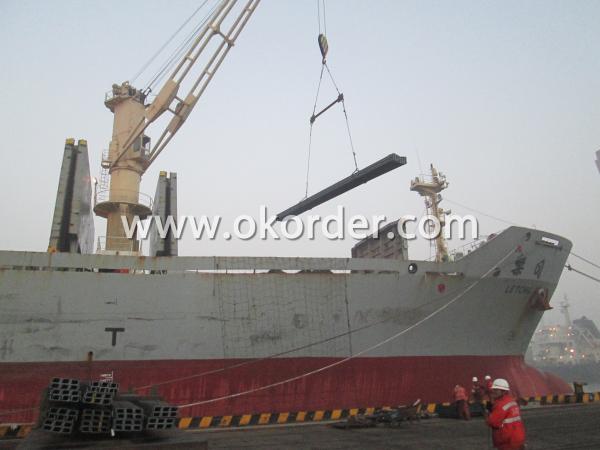
5. Delivery time: All the IPE/IPEAA Beam Steel will be at the port of the shipment within 45 days after receiving the L/C at sight ot the advance pyment.
6. Payment: L/C at sight; 30% advance payment before production, 70% before shipment by T/T, etc.
Production flow of IPE/IPEAA Beams
Material prepare (billet) —heat up—rough rolling—precision rolling—cooling—packing—storage and transportation
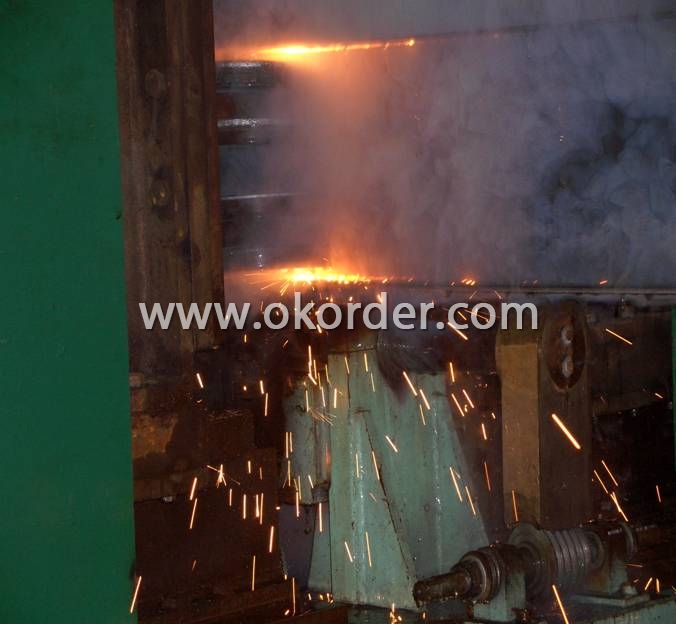
- Q:How do you determine the appropriate size and shape of a steel I-beam for a specific application?
- Several key factors need to be considered when determining the appropriate size and shape of a steel I-beam for a specific application. The first step is to understand the load requirements, including the magnitude and distribution of the load that the I-beam will bear. Engineers typically consult structural design codes and standards, such as the AISC Manual, to determine the appropriate size. These codes provide guidelines and equations to calculate the required section modulus and moment of inertia for a given load. The shape of the I-beam is also crucial in meeting the application's requirements. Different shapes, such as W-shapes, S-shapes, and HP-shapes, offer different properties in terms of strength, stiffness, and resistance to bending and deflection. Aside from load requirements, other factors to consider include the available space for installation, the type of support structure, and the desired aesthetic appearance. It is highly recommended to consult with a structural engineer or a professional familiar with steel beam design to ensure the selection of the appropriate size and shape for the specific application.
- Q:How do steel I-beams perform in terms of deflection or bending?
- Steel I-beams are renowned for their exceptional deflection and bending capabilities. Their structural design grants them a moment of inertia, which renders them highly resistant to bending or deflection when subjected to a load. The I-beam's shape, characterized by elongated top and bottom flanges connected by a narrower web, facilitates the uniform distribution of the load along the beam's length, thereby minimizing deflection. The robustness of steel further contributes to the I-beam's superior performance. Steel stands as one of the most formidable construction materials, boasting remarkable tensile strength and stiffness. Consequently, steel I-beams can endure substantial loads without succumbing to significant deflection or bending. Additionally, steel I-beams can be reinforced by enlarging their size or incorporating additional stiffeners or bracing. This augmented reinforcement amplifies their resistance to deflection or bending, rendering them suitable for an extensive array of applications, encompassing skyscrapers, bridges, and industrial edifices. In conclusion, the deflection or bending performance of steel I-beams distinguishes itself through the amalgamation of their structural design and the strength of steel. Their ability to uniformly distribute loads and withstand bending or deflection positions them as a reliable choice for diverse construction endeavors.
- Q:How do steel I-beams compare to wooden beams in terms of strength?
- Steel I-beams are significantly stronger than wooden beams in terms of strength. Steel is a much stronger material than wood, and I-beams are specifically designed to maximize their load-bearing capacity. The shape of an I-beam allows it to distribute weight evenly along its length, making it capable of handling much larger loads than wooden beams of similar dimensions. Additionally, steel I-beams have a high resistance to bending and twisting, making them ideal for supporting heavy loads and providing structural stability. In contrast, wooden beams have a lower strength-to-weight ratio and are more prone to warping, bowing, or breaking under heavy loads. Therefore, steel I-beams are the preferred choice for construction projects where strength and durability are crucial factors.
- Q:How do steel I-beams perform in high-humidity environments?
- Due to their inherent resistance to moisture, steel I-beams perform well in high-humidity environments. Typically, the steel used in I-beams is coated with protective finishes like galvanization or paint. These finishes act as barriers to prevent moisture penetration and direct contact with water or humidity, thus preventing corrosion. Moreover, steel is a non-porous material, unlike wood or other organic materials. This non-porous characteristic makes steel I-beams less prone to swelling, warping, or rotting that can occur in high-humidity conditions. However, in extremely corrosive environments such as coastal areas with high salt content in the air, additional precautions may be necessary. In such cases, stainless steel or other corrosion-resistant alloys are commonly utilized to ensure the durability and performance of the I-beams. All in all, steel I-beams are a reliable choice for high-humidity environments. They offer strength, durability, and resistance to moisture-related issues.
- Q:How do steel I-beams perform in high-temperature environments?
- Steel I-beams perform well in high-temperature environments due to their inherent strength and heat resistance. Steel has a high melting point, which makes it suitable for withstanding elevated temperatures. In a high-temperature environment, steel I-beams retain most of their structural integrity and load-bearing capacity. However, it is important to note that steel's strength decreases as the temperature rises. At temperatures exceeding 500°C (932°F), the steel may start to lose its load-bearing capacity. Additionally, prolonged exposure to high heat can cause steel to deform or warp, which might compromise its structural integrity. Therefore, in extreme high-temperature environments, additional fire protection measures such as fire-resistant coatings or insulation may be necessary to maintain the I-beams' performance. Overall, steel I-beams are a reliable choice for use in high-temperature environments, but caution should be exercised in extreme conditions to ensure their long-term effectiveness.
- Q:Are steel I-beams flexible or rigid?
- Steel I-beams are rigid. They are designed to provide maximum structural support and minimize deflection under heavy loads. The shape of an I-beam, with its flanges and web, allows it to distribute weight evenly along its length, making it highly resistant to bending or flexing. This rigidity is crucial in construction and engineering applications where stability and strength are paramount.
- Q:What is the maximum deflection allowed for a steel I-beam?
- Industry standards and building codes typically establish the maximum deflection permitted for a steel I-beam. These standards vary depending on the particular application and type of structure under construction. However, as a general rule, steel I-beams often have a maximum deflection limit of L/360 or L/240, where L represents the beam's span length. This ensures that the beam's deflection does not exceed 1/360th or 1/240th of the span length. By enforcing this limit, the beam's structural integrity and stability are preserved, preventing excessive bending or sagging that could compromise the structure's safety and performance. To determine the precise maximum deflection limits for a steel I-beam, it is important to refer to the relevant building codes and standards that apply to the specific project.
- Q:What are the considerations for deflection limits in steel I-beam design?
- When designing steel I-beams, it is important to take into account several considerations regarding deflection limits. Deflection refers to the bending or flexing of a structural member under load. To ensure the structural integrity and functionality of the steel I-beam, it is crucial to limit deflection within acceptable limits. Here are some key factors to consider when setting deflection limits in steel I-beam design: 1. Serviceability: Maintaining serviceability is a primary concern when determining deflection limits. Excessive deflection can cause discomfort or inconvenience for occupants, especially in structures like floors or bridges. Establishing deflection limits that provide a satisfactory level of serviceability is crucial to ensure the structure remains comfortable and functional for its intended use. 2. Aesthetic Considerations: Deflection limits are also important from an aesthetic perspective. Excessive deflection can result in visible deformations or sagging, compromising the visual appeal of the structure. Setting appropriate deflection limits allows designers to maintain the desired appearance of the steel I-beams. 3. Structural Stability: Another critical consideration for deflection limits is the overall stability of the structure. Excessive deflection may lead to structural instability, causing the steel I-beam to buckle or fail under load. By setting appropriate deflection limits, designers can ensure that the structure remains stable and can safely support the intended loads without compromising its integrity. 4. Material and Design Standards: Deflection limits are often determined based on industry standards and codes, such as those provided by organizations like the American Institute of Steel Construction (AISC). These standards consider factors such as the material properties of the steel, design loads, and safety factors. Compliance with these standards is crucial to ensure that the steel I-beam design meets the required performance criteria. 5. Load Types: The type of loads that the steel I-beam will be subjected to also influence the deflection limits. Different load types, such as dead loads (permanent loads like the weight of the structure itself) and live loads (temporary loads like occupants or furniture), have varying deflection limits. The design should account for these different load types and establish appropriate deflection limits accordingly. In conclusion, the considerations for deflection limits in steel I-beam design revolve around ensuring serviceability, maintaining aesthetic appeal, ensuring structural stability, complying with industry standards, and accounting for different load types. By carefully considering these factors, designers can determine appropriate deflection limits that will result in a safe, functional, and aesthetically pleasing steel I-beam design.
- Q:Can steel I-beams be used for long-span structures?
- Long-span structures can indeed utilize steel I-beams. Renowned for their robustness and capacity to bear substantial loads, steel I-beams prove fitting for long-span structures like bridges, industrial edifices, and expansive commercial spaces. The incorporation of steel I-beams enables the development of unobstructed and roomy areas without necessitating intermediate supports. Moreover, steel I-beams facilitate effortless connection and fabrication for extended spans, thus affording flexibility in both design and construction. The elevated strength-to-weight ratio of steel further establishes it as the favored choice for long-span structures, permitting lighter constructions while maintaining unwavering strength and stability. Ultimately, owing to their endurance, strength, and adaptability, steel I-beams enjoy extensive employment within the construction sector for long-span structures.
- Q:How do steel I-beams perform in extreme temperatures?
- Steel I-beams are known for their excellent performance in extreme temperatures. Due to the inherent properties of steel, I-beams exhibit high strength, durability, and resistance to thermal expansion and contraction. These characteristics make them well-suited for withstanding extreme temperatures. In extreme cold temperatures, steel I-beams remain structurally stable and maintain their strength. Steel has a low coefficient of thermal expansion, meaning it does not contract significantly when exposed to low temperatures. This prevents any significant changes in the dimensions or deformations of the I-beams, ensuring their load-bearing capacity remains intact. Similarly, in extreme heat, steel I-beams also exhibit excellent performance. Steel has a high melting point, allowing it to withstand high temperatures without losing its structural integrity. Additionally, steel has a high thermal conductivity, which means it efficiently dissipates heat, preventing localized hotspots or weakening of the I-beams due to excessive temperature exposure. Furthermore, steel I-beams have proven to be highly fire-resistant. They do not ignite, contribute to the spread of flames, or release toxic gases when exposed to high temperatures. This characteristic is crucial for maintaining the structural integrity of buildings or structures during fire emergencies. Overall, steel I-beams are designed and manufactured to perform exceptionally well in extreme temperatures, making them a reliable choice for various applications. Whether subjected to extreme cold or heat, these beams maintain their strength, stability, and durability, ensuring the safety and longevity of the structures they support.
1. Manufacturer Overview |
|
|---|---|
| Location | |
| Year Established | |
| Annual Output Value | |
| Main Markets | |
| Company Certifications | |
2. Manufacturer Certificates |
|
|---|---|
| a) Certification Name | |
| Range | |
| Reference | |
| Validity Period | |
3. Manufacturer Capability |
|
|---|---|
| a)Trade Capacity | |
| Nearest Port | |
| Export Percentage | |
| No.of Employees in Trade Department | |
| Language Spoken: | |
| b)Factory Information | |
| Factory Size: | |
| No. of Production Lines | |
| Contract Manufacturing | |
| Product Price Range | |
Send your message to us
IPEAA, IPE Steel Beams
- Loading Port:
- Tianjin
- Payment Terms:
- TT OR LC
- Min Order Qty:
- -
- Supply Capability:
- 100000 m.t./month
OKorder Service Pledge
OKorder Financial Service
Similar products
New products
Hot products
Related keywords
